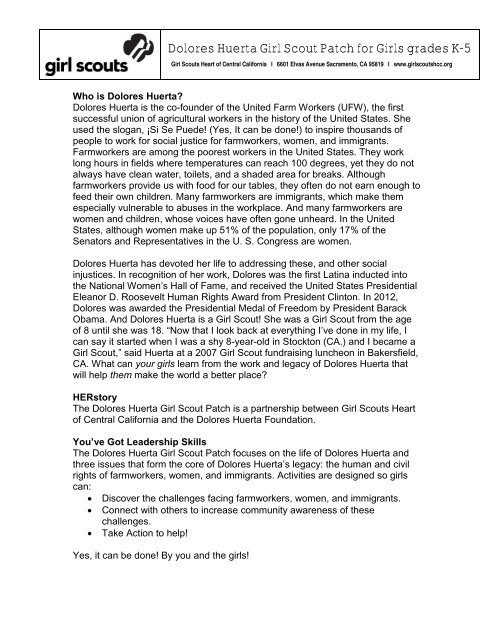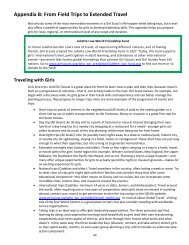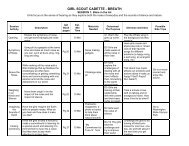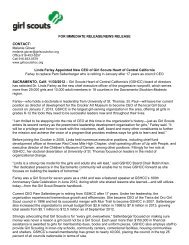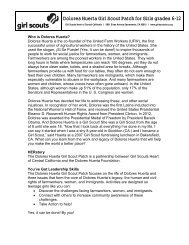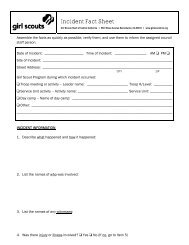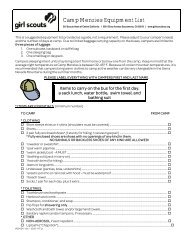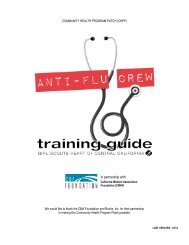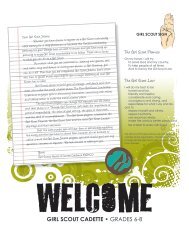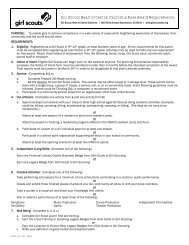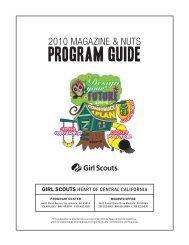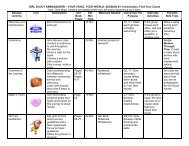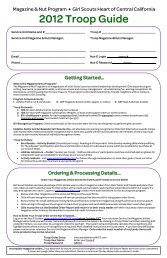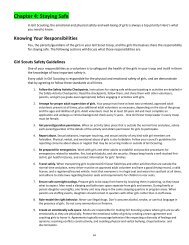Dolores Huerta Patch Program for Girls grades 6-12 - Girl Scouts ...
Dolores Huerta Patch Program for Girls grades 6-12 - Girl Scouts ...
Dolores Huerta Patch Program for Girls grades 6-12 - Girl Scouts ...
You also want an ePaper? Increase the reach of your titles
YUMPU automatically turns print PDFs into web optimized ePapers that Google loves.
<strong>Dolores</strong> <strong>Huerta</strong> <strong>Girl</strong> Scout <strong>Patch</strong> <strong>for</strong> <strong><strong>Girl</strong>s</strong> <strong>grades</strong> K-5<br />
<strong>Girl</strong> <strong>Scouts</strong> Heart of Central Cali<strong>for</strong>nia I 6601 Elvas Avenue Sacramento, CA 95819 I www.girlscoutshcc.org<br />
Who is <strong>Dolores</strong> <strong>Huerta</strong>?<br />
<strong>Dolores</strong> <strong>Huerta</strong> is the co-founder of the United Farm Workers (UFW), the first<br />
successful union of agricultural workers in the history of the United States. She<br />
used the slogan, ¡Si Se Puede! (Yes, It can be done!) to inspire thousands of<br />
people to work <strong>for</strong> social justice <strong>for</strong> farmworkers, women, and immigrants.<br />
Farmworkers are among the poorest workers in the United States. They work<br />
long hours in fields where temperatures can reach 100 degrees, yet they do not<br />
always have clean water, toilets, and a shaded area <strong>for</strong> breaks. Although<br />
farmworkers provide us with food <strong>for</strong> our tables, they often do not earn enough to<br />
feed their own children. Many farmworkers are immigrants, which make them<br />
especially vulnerable to abuses in the workplace. And many farmworkers are<br />
women and children, whose voices have often gone unheard. In the United<br />
States, although women make up 51% of the population, only 17% of the<br />
Senators and Representatives in the U. S. Congress are women.<br />
<strong>Dolores</strong> <strong>Huerta</strong> has devoted her life to addressing these, and other social<br />
injustices. In recognition of her work, <strong>Dolores</strong> was the first Latina inducted into<br />
the National Women’s Hall of Fame, and received the United States Presidential<br />
Eleanor D. Roosevelt Human Rights Award from President Clinton. In 20<strong>12</strong>,<br />
<strong>Dolores</strong> was awarded the Presidential Medal of Freedom by President Barack<br />
Obama. And <strong>Dolores</strong> <strong>Huerta</strong> is a <strong>Girl</strong> Scout! She was a <strong>Girl</strong> Scout from the age<br />
of 8 until she was 18. “Now that I look back at everything I’ve done in my life, I<br />
can say it started when I was a shy 8-year-old in Stockton (CA.) and I became a<br />
<strong>Girl</strong> Scout,” said <strong>Huerta</strong> at a 2007 <strong>Girl</strong> Scout fundraising luncheon in Bakersfield,<br />
CA. What can your girls learn from the work and legacy of <strong>Dolores</strong> <strong>Huerta</strong> that<br />
will help them make the world a better place?<br />
HERstory<br />
The <strong>Dolores</strong> <strong>Huerta</strong> <strong>Girl</strong> Scout <strong>Patch</strong> is a partnership between <strong>Girl</strong> <strong>Scouts</strong> Heart<br />
of Central Cali<strong>for</strong>nia and the <strong>Dolores</strong> <strong>Huerta</strong> Foundation.<br />
You’ve Got Leadership Skills<br />
The <strong>Dolores</strong> <strong>Huerta</strong> <strong>Girl</strong> Scout <strong>Patch</strong> focuses on the life of <strong>Dolores</strong> <strong>Huerta</strong> and<br />
three issues that <strong>for</strong>m the core of <strong>Dolores</strong> <strong>Huerta</strong>’s legacy: the human and civil<br />
rights of farmworkers, women, and immigrants. Activities are designed so girls<br />
can:<br />
• Discover the challenges facing farmworkers, women, and immigrants.<br />
• Connect with others to increase community awareness of these<br />
challenges.<br />
• Take Action to help!<br />
Yes, it can be done! By you and the girls!
The <strong>Dolores</strong> <strong>Huerta</strong> <strong>Girl</strong> Scout <strong>Patch</strong> is dedicated to <strong>Dolores</strong> <strong>Huerta</strong> and all the<br />
people <strong>for</strong> whom she provides a voice.<br />
Important!<br />
To earn the <strong>Dolores</strong> <strong>Huerta</strong> <strong>Girl</strong> Scout <strong>Patch</strong>, girls need to be registered as<br />
a <strong>Girl</strong> Scout. Annual membership is $<strong>12</strong>. Financial assistance is available.<br />
<strong><strong>Girl</strong>s</strong> in <strong>grades</strong> K-<strong>12</strong> can earn the patch. There is a companion curriculum <strong>for</strong><br />
girls in <strong>grades</strong> 6-<strong>12</strong>. Both curriculums are available in English and in Spanish at<br />
www.girlscoutshcc.org.<br />
What girls need to do to earn this patch:<br />
• Do the one REQUIRED activity.<br />
• Select one topic area (Farmworkers, Women, or Immigrants) and do ONE<br />
activity of their choice from each of the THREE categories (DISCOVER,<br />
CONNECT, TAKE ACTION).<br />
• Participate in a short REFLECTION after they have completed the<br />
activities.<br />
Notes on planning the Project:<br />
Help girls make connections between the Discover, Connect, and Take Action<br />
“steps” when girls are selecting which activities they will do. The activities are<br />
designed so girls can choose a topic and follow through with the three steps.<br />
Leaders can adjust activities as needed to fit the grade level of the girls. A sheet<br />
<strong>for</strong> girls to track their progress is included at the end of this document.<br />
<strong>Dolores</strong> <strong>Huerta</strong> <strong>Girl</strong> Scout <strong>Patch</strong><br />
Required<br />
• The first step is <strong>for</strong> girls to learn about <strong>Dolores</strong> <strong>Huerta</strong>. An excellent<br />
resource is the new bi-lingual children’s book, Side by Side/Lado a Lado:<br />
The Story of <strong>Dolores</strong> <strong>Huerta</strong> and Cesar Chavez by Moncia Brown. The<br />
book includes a wonderful drawing of <strong>Dolores</strong> selling <strong>Girl</strong> Scout cookies to<br />
raise money to help soldiers during World War II. In addition, there is a<br />
brief biography on-line that adult leaders can read. It includes the impact<br />
<strong>Girl</strong> <strong>Scouts</strong> had on <strong>Dolores</strong>’s life. Visit the <strong>Girl</strong> <strong>Scouts</strong> Heart of Central<br />
Cali<strong>for</strong>nia web-site at www.girlscoutshcc.org and read the “<strong>Dolores</strong> <strong>Huerta</strong><br />
Biography” in the section about the <strong>Dolores</strong> <strong>Huerta</strong> <strong>Girl</strong> Scout <strong>Patch</strong>.<br />
• As you are reading, consider questions such as: Who was a major<br />
influence in <strong>Dolores</strong>’ life as she was growing up? Why? What was<br />
<strong>Dolores</strong>’ <strong>Girl</strong> Scout troop like? What did <strong>Dolores</strong> learn as a <strong>Girl</strong> Scout?<br />
How did <strong>Dolores</strong> first experience racism? Why did <strong>Dolores</strong> decide to<br />
organize farmworkers? What are some examples of social injustice? How<br />
did <strong>Dolores</strong> fight <strong>for</strong> social justice? What did <strong>Dolores</strong> accomplish through<br />
her ef<strong>for</strong>ts at lobbying legislators on behalf of farmworkers and<br />
immigrants? How did <strong>Dolores</strong> and Cesar Chavez begin working together?<br />
Why did they decide to <strong>for</strong>m a union <strong>for</strong> farmworkers? What is a union?
What rights and benefits did United Farm Workers (UFW) union contracts<br />
guarantee <strong>for</strong> farmworkers working at companies where there were<br />
contracts? What roles did <strong>Dolores</strong> play in the United Farm Workers<br />
(UFW)? How did <strong>Dolores</strong> begin fighting <strong>for</strong> women’s rights? How has<br />
<strong>Dolores</strong> been recognized <strong>for</strong> her role in working <strong>for</strong> social justice <strong>for</strong><br />
farmworkers, women, and immigrants?<br />
• Leaders can use the children’s book, the on-line biography, and other<br />
in<strong>for</strong>mation they may be aware of to teach the girls about <strong>Dolores</strong> <strong>Huerta</strong>.<br />
Another option is to partner with an older girl troop (<strong>grades</strong> 6-<strong>12</strong>) that is<br />
working on the patch, and have them present the story of <strong>Dolores</strong> to your<br />
girls.<br />
• After girls have learned about <strong>Dolores</strong>, have a conversation with the girls<br />
about the <strong>Girl</strong> Scout mission, “<strong>Girl</strong> <strong>Scouts</strong> builds girls of courage,<br />
confidence, and character who make the world a better place” and<br />
about how <strong>Dolores</strong> lives it. How has <strong>Dolores</strong> demonstrated Courage?<br />
Confidence? Character? How has <strong>Dolores</strong> helped to Make the World a<br />
Better Place? Ask girls to reflect on their own experiences. How have they<br />
shown Courage? Confidence? Character? How have they helped to Make<br />
the World a Better Place or how would they like to do that? Another option<br />
would be to have a discussion about how <strong>Dolores</strong> lives the Promise and/or<br />
the Law.<br />
• After the discussion, have the girls create a response based on what they<br />
have learned about <strong>Dolores</strong> <strong>Huerta</strong> and her life’s work. The response can<br />
take whatever <strong>for</strong>m fits best <strong>for</strong> the girls. <strong><strong>Girl</strong>s</strong> can work individually or with<br />
others. After they have prepared the response, have the girls share with<br />
others in their troop, with a different troop, or with another group in your<br />
local community. Some possible choices are: An oral presentation; a<br />
poem, story, dance, skit or song; or a drawing, painting, clay sculpture, or<br />
mural.<br />
Topic Areas<br />
Farmworkers - Please note: Choices under #1 can be done by any girl no<br />
matter where she lives whether or not she has direct contact with farmworkers.<br />
Choices under #2 can be done by girls from farmworker families or by girls who<br />
live in areas with farmworker communities.<br />
Discover<br />
1. Select a book about farmworkers and read to, or with the girls, depending<br />
on their age. Ideas <strong>for</strong> books: 1) Gathering in the Sun: An Alphabet in<br />
Spanish and English by Alma Flor Ada, illustrated by Simon Silva. This is<br />
a beautiful bi-lingual book of paintings and poems that capture the life of<br />
migrant workers with each letter of the alphabet. Although listed <strong>for</strong><br />
children <strong>grades</strong> K-4, this book can be appreciated by girls (and adults) of<br />
any age. 2) La Mariposa (The Butterfly) by Francisco Jiménez, tells the<br />
story of a son of migrant farmworkers who struggles to start school without
understanding English. The book is in English, flavored with Spanish, and<br />
with a glossary of the Spanish words. This book could be read to girls in<br />
<strong>grades</strong> K-4, and would also be appropriate <strong>for</strong> the section on immigrants.<br />
2. If girls have family members or family friends who have worked as<br />
farmworkers, girls could ask if they can interview them. Some sample<br />
questions are: “What is your name? When did you begin working in the<br />
fields? Where did/do you work? Did you migrate to find work? What crops<br />
did/do you work in? What were/are you jobs? What were/are the working<br />
conditions like? Did you ever work at a ranch with a union contract? Were<br />
conditions different? If so, how? What was/is the most difficult part of<br />
doing farmwork? What was/is the most satisfying part of doing farmwork?<br />
Is there anything else you would like to add?” Encourage the girls to add<br />
other questions that they are interested in.<br />
Connect<br />
1. Discuss the book the girls read as a group. If you are helping a Juliette<br />
<strong>Girl</strong> Scout, discuss with her. You may want to create some questions to<br />
get started. Include “What do you think your life would be like if you were<br />
the child of a migrant farmworker?.<br />
2. Have the girls share their interview with the members of their troop.<br />
Take Action<br />
1. Have the girls write an essay, poem, or story; or have them draw or paint<br />
a picture about what they learned about migrant farmworkers, or what they<br />
think it would be like to be the child of a migrant farmworker. Have them<br />
share within their troop or with another troop.<br />
2. Have the girls write an essay, poem, or story; or have them draw or paint<br />
a picture about what they learned from their interview. Have them share<br />
within their troop, or with another troop. Ask them to write or draw a thank<br />
you letter to the person that they interviewed.<br />
Women: Elected Officials and Activists<br />
Discover<br />
Read to, or with, the girls about either an elected woman official, or a<br />
woman activist. A resource <strong>for</strong> elected officials is Madam President: The<br />
Extraordinary, True, and Evolving Story of Women in Politics by Catherine<br />
Thimmesh. A young cartoon girl who aspires to be president learns about<br />
women leaders from various parts of the world. A resource <strong>for</strong> women<br />
activists is Amelia to Zora: Twenty-six Women Who Changed the World by<br />
Cynthia Chin-Lee. (D is <strong>for</strong> <strong>Dolores</strong>). The audience <strong>for</strong> both books is girls<br />
in <strong>grades</strong> 4-7. Perhaps Junior <strong>Girl</strong> <strong>Scouts</strong> could read one of the books,<br />
and then tell younger girls about their favorite woman as a way to use<br />
these materials <strong>for</strong> girls in <strong>grades</strong> K-3. Another option would be to invite a<br />
local woman elected official, or woman activist to attend a troop meeting<br />
and tell her story.
Connect<br />
Engage the girls in a discussion related to one of the books, or to a visit by<br />
an activist woman to your troop. Consider such questions as: “What do<br />
you think it would be like to be elected to office, or to be an advocate?”<br />
“What would you like to do to make the world a better place?”<br />
Take Action<br />
Have the girls write an essay, poem, or story; or have them draw or paint<br />
a picture about what they learned, or about their ideas of what it would be<br />
like to be a woman elected official or advocate. Have them share within<br />
their troop or with another troop.<br />
Immigrants<br />
Discover<br />
Have girls talk to a member(s) of their family. Questions could include:<br />
“What country (ies) did our ancestors come from?” “Why did they<br />
immigrate to the United States?” If a girl’s ancestry includes Native-<br />
Americans, have them ask how the immigration of others affected them. If<br />
a girl’s family includes African-Americans or others who came as slaves or<br />
indentured servants, have them ask how that impacted their family. <strong><strong>Girl</strong>s</strong><br />
who are adopted could explore the ancestry of their adopted parents to<br />
get a sense of the immigrant experience. Whatever a girl’s family<br />
background, have them ask what challenges their ancestors faced and<br />
what contributions they made.<br />
Connect<br />
After girls have talked to their family members, have them discuss their<br />
experiences in your troop meeting. If you are working with a Juliette,<br />
discuss with her. Ask the girls to consider what their life might be like<br />
today if their ancestors had not come to the United States. Ask them to<br />
imagine what it might be like <strong>for</strong> a girl coming to the United States today<br />
from another country. If any of the girls are recent immigrants, you may<br />
want to invite them to talk about what challenges they face. For<br />
background, adults could view a movie about a girl who is a recent<br />
immigrant or daughter of recent immigrants. Some possible movies are<br />
“Real Women Have Curves”, and “Bend it like Beckham.” Another good<br />
resource is the book, Voices from the Fields: Children of Migrant<br />
Farmworkers by Beth Atkin. This book includes stories, poems, and<br />
photos by migrant farmworker children.<br />
Take Action<br />
Have the girls write an essay, poem, or story; or have them draw or paint<br />
a picture that reflects their ancestors’ experience, or how their own life<br />
might be different if their ancestors had not immigrated to America. If a girl<br />
is a recent immigrant herself, she could focus on her own experiences.<br />
Have the girls share what they create within their troop, or with another<br />
troop. Ask them to write or draw a thank you letter to the person(s) they<br />
interviewed.
Reflection<br />
<strong>Girl</strong> Scout Promise and Law<br />
The <strong>Girl</strong> Scout Promise and Law are shared by every member of <strong>Girl</strong> Scouting.<br />
The <strong>Girl</strong> Scout Promise is the way <strong>Girl</strong> <strong>Scouts</strong> agree to act every day toward one<br />
another and other people, and the Law outlines a way to act towards one another<br />
and the world.<br />
The <strong>Girl</strong> Scout Promise<br />
On my honor, I will try:<br />
To serve God* and my country,<br />
To help people at all times,<br />
And to live by the <strong>Girl</strong> Scout Law.<br />
The <strong>Girl</strong> Scout Law<br />
I will do my best to be<br />
honest and fair,<br />
friendly and helpful,<br />
considerate and caring,<br />
courageous and strong, and<br />
responsible <strong>for</strong> what I say and do,<br />
And to<br />
respect myself and others,<br />
respect authority,<br />
use resources wisely,<br />
make the world a better place, and<br />
be a sister to every <strong>Girl</strong> Scout.<br />
*The word “God” can be interpreted in a number of ways, depending on one’s<br />
spiritual beliefs. When reciting the <strong>Girl</strong> Scout Promise, it is okay to replace the<br />
word “God” with whatever word your spiritual beliefs dictate.<br />
Ask the girls<br />
Ask the girls to review the Promise and Law, and think about “What part of the<br />
Promise and Law relates to what you did to earn the <strong>Dolores</strong> <strong>Huerta</strong> <strong>Girl</strong> Scout<br />
<strong>Patch</strong>?” Have the girls share their reflections with you as part of a troop meeting.<br />
<strong><strong>Girl</strong>s</strong> might also like<br />
If the girls in your troop enjoyed earning the <strong>Dolores</strong> <strong>Huerta</strong> <strong>Girl</strong> Scout <strong>Patch</strong>,<br />
they might also enjoy the <strong>Girl</strong> Scout Junior Journey book, Agent of Change,<br />
published by <strong>Girl</strong> <strong>Scouts</strong> of the USA, 2008.<br />
Copyrighted 2009 by <strong>Girl</strong> <strong>Scouts</strong> Heart of Central Cali<strong>for</strong>nia
Sample Worksheet <strong>for</strong> Farmworkers/Discover Step<br />
If you have family members or family friends who have worked as<br />
farmworkers, ask them if you can interview them. Some sample<br />
questions are:<br />
1. What is your name?<br />
2. When did you begin working in the fields?<br />
3. Where did you work?<br />
4. Did you migrate to find work?<br />
5. What crops did you work in?<br />
6. What were your jobs?<br />
7. What were the working conditions like?<br />
8. Did you ever work at a ranch with a union contract?<br />
9. Were conditions different?<br />
10. If so, how?<br />
11. What is the most difficult part of doing farm work?<br />
<strong>12</strong>. What is the most satisfying part of doing farm work?<br />
13. Add other questions you are interested in.
Progress Sheet <strong>for</strong> <strong><strong>Girl</strong>s</strong><br />
Step 1 Learn about <strong>Dolores</strong> <strong>Huerta</strong><br />
Step 2 Create a response based on what you learned and share it with others<br />
Step 3 Decide on your topic area: farmworkers, women, or immigrants<br />
Step 4 Do the Discover step <strong>for</strong> your topic<br />
Step 5 Do the Connect step <strong>for</strong> your topic<br />
Step 6 Do the Take Action step <strong>for</strong> your topic<br />
Step 7 Reflect on your experience earning the <strong>Dolores</strong> <strong>Huerta</strong> <strong>Girl</strong> Scout <strong>Patch</strong>


